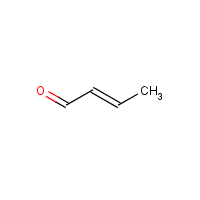Crotonaldehyde
Agent Name
Crotonaldehyde
CAS Number
4170-30-3
Formula
C4-H6-O
Major Category
Toxic Gases & Vapors

Synonyms
1-Formylpropene; 2-Butenal; 2-Butenaldehyde; AI3-18303 (USDA); Crotonal; Crotonic aldehyde; Crotylaldehyde; Krotonaldehyd [Czech]; Methylpropenal; Propylene aldehyde; UN 1143; beta-Methylacrolein; [ChemIDplus] UN1143
Category
Other Toxic Gases & Vapors
Description
Water-white liquid with a suffocating odor; Note: Turns pale-yellow on contact with air; [NIOSH]
Sources/Uses
Used in the synthesis of other organic chemicals; [ACGIH]
Comments
Rats exposed to 1500 ppm, a lethal concentration, develop pulmonary edema. [ACGIH] Liquid causes second degree burns after contact for a few minutes. [CHRIS] Also CAS # 123-73-9; A lachrymator; [CHEMINFO] Corrosive to the eyes; Causes lachrymation; Can cause pulmonary edema; [ICSC] Crotonaldehyde (UN1143) has warning of explosive polymerization; [ERG 2016]
Reference Link #1
Biomedical References
Exposure Assessment
Skin Designation (ACGIH)
Yes
TIH
Yes
Ceiling (ACGIH)
0.3 ppm
PEL (OSHA)
2 ppm
IDLH (NIOSH)
50 ppm
Excerpts from Documentation for IDLHs
Human data: Exposure to 4.1 ppm for 15 minutes was highly irritating to the nose and upper respiratory tract and produced lacrimation in 30 seconds [Sim and Pattle 1957]. In another study, exposures to 45 ppm proved very disagreeable after a few seconds, with conjunctival irritation evident [Rinehart 1967].
Vapor Pressure
30 mm Hg
Odor Threshold Low
0.06 ppm
Odor Threshold High
0.2 ppm
RD50
3 ppm
Lethal Concentration
LC50 (rat) = 200 mg/m3/2H
Explosive Polymerization
Yes
Explanatory Notes
Detection odor threshold from AIHA (mean = 0.11 ppm); The Guide from the Emergency Response Guidebook is for "crotonaldehyde, inhibited." Flash point = 13 deg C; VP from HSDB;
Reference Link #2
NFPA
may ignite at ambient temp
ERPG-1
0.2 ppm
ERPG-2
5 ppm
ERPG-3
15 ppm
Adverse Effects
Lachrymator
Yes
Toxic Pneumonitis
Yes
Dermatotoxin
Skin burns
IARC Carcinogen
Possible (2b)
ACGIH Carcinogen
Confirmed Animal
Diseases, Processes, and Activities Linked to This Agent
Diseases
Occupational diseases associated with exposure to this agent: